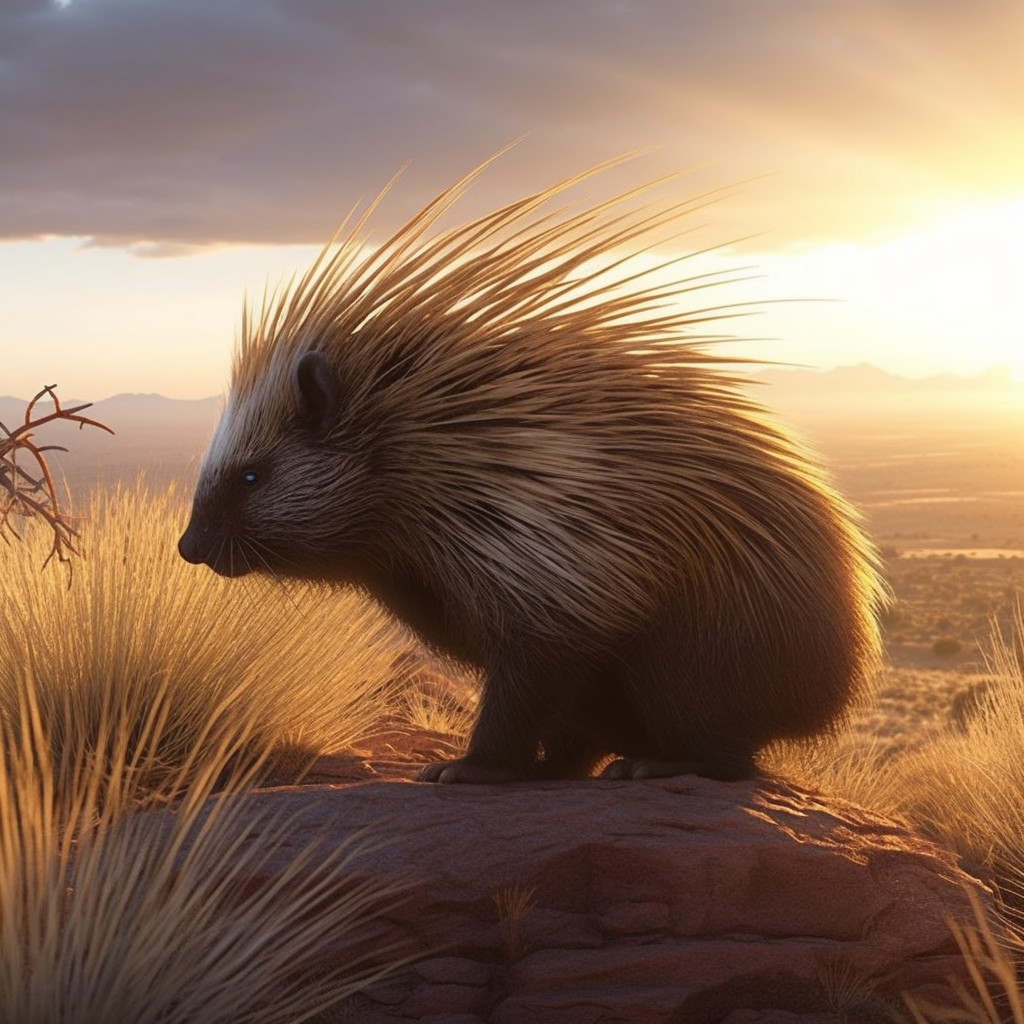Porcupines are fascinating creatures known for their unique quills that cover their bodies. These spiky mammals are found in various parts of the world, including North and South America, Europe, Africa, and Asia. However, there is growing concern about the future of porcupines and whether they are at risk of extinction. In this article, we will explore the current status of porcupines, the factors contributing to their decline, and the conservation efforts being made to protect these intriguing animals. So, let’s delve into the world of porcupines and discover if they are indeed going extinct.
Key Takeaways
- Porcupines are not currently going extinct.
- However, some species of porcupines are considered vulnerable or threatened.
- Habitat loss and illegal hunting are the main threats to porcupine populations.
- Conservation efforts are necessary to protect and preserve porcupines and their habitats.
Current Status of Porcupines: Are They Endangered?

A. Understanding the Different Species of Porcupines
Porcupines are fascinating creatures that belong to the rodent family. There are several species of porcupines found across the world, each with its own unique characteristics. Let’s take a closer look at some of the different species of porcupines:
-
North American Porcupine: This is the most well-known species of porcupine and is found in North America. Known for their large size and sharp quills, North American porcupines are primarily herbivores and can be found in a variety of habitats, including forests, grasslands, and deserts.
-
Cape Porcupine: Native to Africa, the Cape porcupine is the largest porcupine species in the world. They have long quills and a muscular body, which helps them defend against predators. Cape porcupines are primarily nocturnal and feed on a variety of plant material.
-
Indian Crested Porcupine: Found in parts of Asia, the Indian crested porcupine is known for its distinctive crest of long quills on its head. These porcupines are adaptable and can be found in a range of habitats, including forests, grasslands, and rocky areas.
-
Prehensile-Tailed Porcupine: Native to Central and South America, the prehensile-tailed porcupine has a long, flexible tail that it uses for climbing trees. These porcupines are excellent climbers and spend most of their time in the trees, feeding on leaves, fruits, and bark.
B. Global Distribution and Habitat of Porcupines
Porcupines have a wide global distribution and can be found in various habitats across different continents. They are adaptable creatures and can survive in diverse environments. Here are some key points about the global distribution and habitat of porcupines:
-
North America: North American porcupines are found in Canada, the United States, and parts of Mexico. They inhabit a range of habitats, including forests, grasslands, and even urban areas.
-
Africa: Porcupines are found throughout Africa, with different species occupying different regions. The Cape porcupine is found in southern Africa, while the crested porcupine is found in North Africa.
-
Asia: Porcupines can be found in various parts of Asia, including India, China, and Southeast Asia. The Indian crested porcupine is the most common species in this region.
-
Central and South America: The prehensile-tailed porcupine is native to this region and can be found in countries such as Brazil, Peru, and Costa Rica.
Porcupines have adapted to a range of habitats, including forests, grasslands, deserts, and rocky areas. They are excellent climbers and can also be found in trees.
C. Threat Status: Are Porcupines Endangered?
While porcupines are not currently classified as endangered, they do face certain threats that could impact their populations in the future. Here are some key factors contributing to the potential endangerment of porcupines:
-
Habitat Loss: As human populations expand and habitats are destroyed or fragmented, porcupines may lose their natural homes. Deforestation, urbanization, and agricultural activities can all lead to habitat loss for porcupines.
-
Poaching and Hunting: Porcupines are sometimes hunted for their meat, quills, or as part of the illegal wildlife trade. Overhunting can have a significant impact on porcupine populations, especially in areas where they are targeted for their quills.
-
Climate Change: The changing climate can also affect porcupines and their habitats. Extreme weather events, such as droughts or floods, can disrupt their food sources and nesting sites, making it harder for them to survive.
-
Ecological Imbalance: Porcupines play an important role in maintaining ecological balance. Their feeding habits help control vegetation growth and disperse seeds. If their populations decline, it can have cascading effects on the ecosystem.
Efforts are being made to protect porcupines and ensure their survival. Conservation organizations are working to raise awareness about the importance of porcupines and their habitats. Additionally, laws and regulations are in place to prevent illegal hunting and trade of porcupines.
In conclusion, while porcupines are not currently endangered, they face various threats that could impact their populations in the future. It is crucial to continue monitoring their status and implementing conservation efforts to protect these unique and valuable creatures.
Delving into Extinction: Are Porcupines Going Extinct?
A. Historical Perspective: Have Porcupines Ever Been Extinct?
When considering the question of whether porcupines are going extinct, it is essential to examine the historical perspective. Porcupines have been a part of our planet’s wildlife for thousands of years, and their presence can be traced back through the annals of time. However, it is important to note that there have been instances where certain porcupine species faced significant population declines.
One such example is the North American porcupine (Erethizon dorsatum), which experienced a decline in the early 1900s due to unregulated hunting and habitat loss. This decline led to concerns about the species’ survival. However, through conservation efforts and increased awareness, the North American porcupine population has since rebounded, and it is no longer considered at risk of extinction.
B. Current Trends: Are Porcupines on the Brink of Extinction?
While some porcupine species have faced challenges in the past, it is crucial to assess the current trends to determine if porcupines are currently on the brink of extinction. The overall picture suggests that while certain populations may be threatened, porcupines as a whole are not currently facing imminent extinction.
One of the main factors contributing to the decline of porcupine populations is habitat loss. As human activities continue to encroach upon natural habitats, porcupines find themselves with fewer suitable areas to thrive. Deforestation, urbanization, and agricultural expansion all contribute to the loss of porcupine habitats. Additionally, climate change impacts such as altered precipitation patterns and temperature fluctuations can further disrupt their ecosystems.
Another significant threat to porcupines is poaching. Porcupines are hunted for their meat, quills, and other body parts, which are used in traditional medicine and crafts. Unregulated hunting can have a severe impact on porcupine populations, especially when combined with habitat loss.
Despite these challenges, there are ongoing conservation efforts aimed at protecting porcupines and their habitats. Wildlife organizations and governments are implementing measures to regulate hunting, establish protected areas, and promote sustainable land management practices. These efforts aim to ensure the survival of porcupines and maintain the ecological balance they contribute to.
In conclusion, while porcupines have faced population declines in the past, they are not currently on the brink of extinction. However, it is crucial to continue monitoring their populations and implementing conservation measures to safeguard their future. By addressing environmental threats, promoting habitat preservation, and raising awareness about the importance of porcupines in our ecosystems, we can contribute to the long-term survival of these unique creatures.
Unraveling the Causes: Why Are Porcupines Endangered?
A. Natural Threats to Porcupine Survival
Porcupines, with their unique quills and solitary nature, have long fascinated wildlife enthusiasts. However, these intriguing creatures are facing numerous challenges that are putting their survival at risk. While some threats to porcupines are natural and have existed for centuries, others are a result of human activities and the changing climate. Let’s delve into the causes behind the endangerment of porcupines and explore the impact of these factors on their populations.
1. Predators and Competition
In the natural world, porcupines have their fair share of predators. Large carnivores such as cougars, bobcats, and wolves pose a threat to porcupines due to their ability to overpower them. These predators have developed techniques to avoid the porcupine’s quills, making them a potential meal. Additionally, porcupines face competition for resources from other herbivores, such as deer and rabbits, which can further impact their survival.
2. Disease and Parasites
Like any other species, porcupines are susceptible to diseases and parasites. Parasites like ticks and fleas can cause discomfort and weaken porcupines, making them more vulnerable to predation. Moreover, diseases such as porcupine viral dermatitis, a condition that affects their skin, can have a significant impact on their overall health and survival.
3. Limited Reproductive Rate
Porcupines have a relatively slow reproductive rate compared to other mammals. They typically have one or two offspring per year, and the young porcupines require a considerable amount of time and care from their mothers. This slow reproductive rate makes it difficult for porcupine populations to recover quickly from declines, further exacerbating their vulnerability to other threats.
B. Human-Induced Factors Endangering Porcupines
While natural threats have always existed, human activities have increasingly become a significant factor contributing to the endangerment of porcupines. The expansion of human populations and the associated development have resulted in habitat loss and fragmentation, directly impacting porcupine populations.
1. Habitat Loss and Fragmentation
Porcupines rely on a specific habitat to meet their survival needs. However, deforestation, urbanization, and agricultural activities have led to the destruction and fragmentation of their habitats. As a result, porcupines are forced to adapt to new and often less suitable environments, which can negatively affect their survival and reproductive success.
2. Hunting and Poaching
Porcupines are hunted for various reasons, including their meat, quills, and as a means of pest control. In some regions, porcupines are considered a delicacy, leading to targeted hunting. Additionally, the illegal wildlife trade poses a significant threat, as porcupines are often poached for their quills, which are used in traditional medicine and crafts.
3. Road Mortality
As human infrastructure expands, porcupines face an increased risk of road mortality. Porcupines are slow-moving animals and may not be able to evade vehicles on roads. Collisions with vehicles can result in severe injuries or death, further impacting their already vulnerable populations.
C. Impact of Climate Change on Porcupine Populations
Climate change is another factor that is affecting porcupine populations worldwide. The changing climate brings about shifts in temperature, precipitation patterns, and vegetation, which can disrupt the delicate balance of ecosystems and impact the survival of porcupines.
1. Altered Habitat and Food Availability
Climate change can lead to changes in the distribution and abundance of vegetation, which directly affects the availability of food for porcupines. As their primary diet consists of bark, twigs, and leaves, any alteration in the vegetation composition can limit their food resources and impact their overall health and reproduction.
2. Increased Disease Risk
Climate change can also increase the risk of diseases in porcupine populations. Rising temperatures and changing weather patterns can create favorable conditions for the proliferation of disease-causing organisms, such as bacteria and viruses. This increased disease risk can further weaken porcupines and contribute to population declines.
3. Disrupted Ecological Interactions
The changing climate can disrupt the intricate ecological interactions that porcupines have with other species. For example, changes in vegetation patterns can affect the availability of suitable denning sites for porcupines, which can impact their reproductive success. Additionally, alterations in the timing of seasonal events, such as flowering and migration, can disrupt the synchronization between porcupines and their food sources.
In conclusion, porcupines face a combination of natural and human-induced threats that are endangering their populations. Predators, competition, disease, limited reproductive rate, habitat loss, hunting, road mortality, and climate change all contribute to the challenges faced by these unique creatures. Understanding these causes is crucial for implementing effective conservation efforts and ensuring the long-term survival of porcupines in our ecosystems.
The Plight of Specific Species: Is the Porcupine Endangered Globally or Locally?

A. Case Study: The North American Porcupine
The North American Porcupine (Erethizon dorsatum) is a fascinating creature that has captured the curiosity of many wildlife enthusiasts. While it may seem like a prickly problem to some, the truth is that the North American Porcupine is not currently at risk of extinction. However, this does not mean that we should ignore the challenges it faces.
Population and Habitat
The North American Porcupine is widely distributed across the continent, from Alaska and Canada to Mexico. Its population is relatively stable, with an estimated 30,000 individuals in the United States alone. These porcupines are adaptable and can thrive in a variety of habitats, including forests, grasslands, and even urban areas.
Threats and Conservation Efforts
Despite their stable population, North American Porcupines still face some environmental threats. Habitat loss due to deforestation and urbanization is a significant concern. As human activities encroach upon their natural habitats, porcupines may struggle to find suitable areas to live and forage for food.
Conservation efforts for the North American Porcupine primarily focus on preserving and restoring their habitats. By protecting forests and promoting sustainable land use practices, we can ensure that these unique creatures have a safe place to call home.
B. Case Study: The African Crested Porcupine
The African Crested Porcupine (Hystrix cristata) is another porcupine species that deserves our attention. Found in various regions of Africa, this species faces different challenges compared to its North American counterpart.
Population and Habitat
The African Crested Porcupine has a wide distribution across sub-Saharan Africa, from Morocco to South Africa. Their population is relatively stable, although specific regions may experience localized declines due to habitat fragmentation and human-wildlife conflict.
These porcupines are adaptable and can thrive in various habitats, including forests, grasslands, and rocky areas. They are known for their impressive digging abilities, creating extensive burrow systems that provide shelter and protection.
Threats and Conservation Efforts
The African Crested Porcupine faces several threats that put its survival at risk. Habitat loss and degradation due to agricultural expansion and urbanization are significant concerns. Additionally, they are often hunted for their meat and quills, which are used in traditional medicine and crafts.
Conservation efforts for the African Crested Porcupine involve raising awareness about the importance of protecting their habitats and implementing measures to reduce human-wildlife conflict. By promoting sustainable land use practices and enforcing regulations against illegal hunting, we can help ensure the survival of this remarkable species.
C. Case Study: The Malayan Porcupine
The Malayan Porcupine (Hystrix brachyura) is a porcupine species native to Southeast Asia. While it may not be as well-known as its counterparts, this species faces its own set of challenges.
Population and Habitat
The Malayan Porcupine is found in various countries, including Malaysia, Indonesia, Thailand, and the Philippines. Its population status is relatively unknown, but it is believed to be stable in some areas while declining in others.
These porcupines inhabit a range of habitats, including forests, grasslands, and agricultural areas. They are known for their ability to adapt to human-modified landscapes, which can be both a blessing and a curse.
Threats and Conservation Efforts
The Malayan Porcupine faces threats similar to other porcupine species, such as habitat loss and hunting. Deforestation and agricultural expansion are major contributors to habitat degradation, forcing porcupines to seek refuge in fragmented landscapes.
Conservation efforts for the Malayan Porcupine involve promoting sustainable land use practices, protecting their habitats, and raising awareness about the importance of preserving biodiversity. By working together, we can ensure that this unique species continues to thrive in its natural environment.
In conclusion, while porcupines as a whole are not currently facing global extinction, specific species like the North American Porcupine, African Crested Porcupine, and Malayan Porcupine still face various environmental threats. By understanding these challenges and implementing effective conservation measures, we can protect these remarkable creatures and contribute to the preservation of our planet’s biodiversity.
Conservation Efforts: Saving the Porcupines from Extinction

A. Existing Conservation Strategies for Porcupines
Porcupines, like many other wildlife species, are facing numerous threats that have led to a decline in their population. However, there are several ongoing conservation strategies aimed at protecting these unique creatures and ensuring their survival for future generations.
One of the primary concerns for porcupines is habitat loss. Deforestation, driven by human activities such as logging and urbanization, has significantly reduced the available habitat for these animals. To combat this issue, conservation organizations are working to preserve and restore porcupine habitats. They focus on creating protected areas, such as national parks and wildlife reserves, where porcupines can thrive undisturbed.
Another crucial aspect of porcupine conservation is addressing the impact of climate change on their habitats. As global temperatures rise, it disrupts the delicate balance of ecosystems, affecting the availability of food and water sources for porcupines. Conservationists are studying the effects of climate change on porcupine populations and working towards implementing measures to mitigate its impact.
B. Role of Wildlife Organizations in Porcupine Preservation
Wildlife organizations play a vital role in the preservation of porcupines and other endangered species. These organizations work tirelessly to raise awareness about the threats faced by porcupines and advocate for their protection. They collaborate with governments, local communities, and other stakeholders to develop and implement conservation plans.
One of the key activities undertaken by wildlife organizations is conducting research to better understand porcupine behavior, habitat requirements, and population dynamics. This knowledge helps inform conservation strategies and enables targeted efforts to protect porcupines effectively.
Additionally, wildlife organizations work towards reducing human-wildlife conflicts. Porcupines are often seen as pests by farmers due to their habit of damaging crops and trees. By providing education and support, wildlife organizations help communities implement non-lethal methods to deter porcupines from agricultural areas, reducing the need for harmful measures such as hunting or poisoning.
C. Community Participation in Porcupine Conservation
Community participation is crucial for the success of porcupine conservation efforts. Local communities living in close proximity to porcupine habitats can play a significant role in protecting these animals and their ecosystems.
Engaging communities in conservation activities fosters a sense of ownership and responsibility towards porcupines. It also helps address the underlying causes of porcupine habitat destruction, such as unsustainable resource extraction or illegal hunting. By involving communities in decision-making processes, conservation initiatives can be tailored to the specific needs and challenges faced by each region.
Furthermore, community participation can lead to the development of sustainable livelihood alternatives that reduce the dependence on activities harmful to porcupines and their habitats. For example, promoting eco-tourism or supporting sustainable agriculture practices can provide economic opportunities while ensuring the long-term conservation of porcupines.
In conclusion, the combined efforts of existing conservation strategies, wildlife organizations, and community participation are crucial in saving porcupines from extinction. By addressing habitat loss, mitigating the impact of climate change, and involving local communities, we can protect these fascinating creatures and contribute to the preservation of global biodiversity. It is essential for us to recognize the value of porcupines and take action to secure their future. Conclusion
In conclusion, while porcupines face certain threats to their survival, such as habitat loss and illegal hunting, there is currently no evidence to suggest that they are going extinct. These unique creatures have adapted well to various environments and continue to thrive in many parts of the world. However, it is important for us to remain vigilant and take measures to protect their habitats and ensure their conservation. By raising awareness, supporting conservation efforts, and promoting responsible behavior, we can help ensure that porcupines and other wildlife species continue to coexist with us for generations to come.
Frequently Asked Questions
Are porcupines endangered?
No, not all species of porcupines are endangered. However, some specific species like the Philippine Porcupine and the Bornean Tufted Ground Porcupine are considered to be threatened due to habitat loss and hunting.
Are porcupines extinct?
No, porcupines are not extinct. They can be found across North and South America, Europe, Asia, and Africa. However, some species are threatened and their populations are declining.
Are porcupines going extinct?
While porcupines as a whole are not going extinct, certain species are threatened due to factors like habitat loss, hunting, and climate change. Conservation efforts are in place to protect these species and prevent their extinction.
Why are porcupines endangered?
Porcupines are endangered due to several factors. Habitat loss due to deforestation and urbanization, hunting and poaching for their meat and quills, and climate change impacts are major threats to their survival.
Is porcupine endangered?
Not all species of porcupines are endangered. However, certain species like the Philippine Porcupine and the Bornean Tufted Ground Porcupine are classified as threatened due to habitat destruction and hunting.
What is causing the Porcupine population decline?
The Porcupine population is declining due to habitat loss from deforestation and urbanization, hunting and poaching for their meat and quills, and the impacts of climate change on their natural habitats.
What are the conservation efforts for porcupines?
Conservation efforts for porcupines include habitat preservation and restoration, implementing laws and regulations to prevent hunting and poaching, and raising awareness about the importance of porcupines in maintaining ecological balance.
How does climate change impact porcupines?
Climate change can impact porcupines by altering their habitats and the availability of food sources. Changes in temperature and precipitation patterns can also affect their breeding and survival rates.
How does deforestation contribute to the endangerment of porcupines?
Deforestation leads to habitat destruction, which is a major threat to porcupine survival. It reduces the availability of food and shelter, increases vulnerability to predators, and disrupts their breeding patterns.
What is the role of wildlife preservation in protecting porcupine species at risk?
Wildlife preservation plays a crucial role in protecting at-risk porcupine species. It involves creating protected areas, restoring habitats, implementing laws against hunting and poaching, and raising public awareness about the importance of biodiversity and the threats faced by these species.




